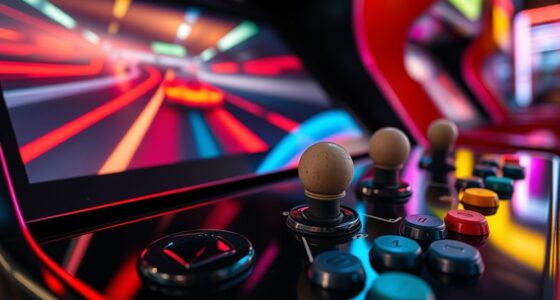The evolution of racing games in arcades has transformed from simple, pixelated tracks to highly detailed, immersive environments thanks to advances in graphics technology. You now experience realistic landscapes, dynamic lighting, and smoother gameplay, all while multiplayer modes let you compete with friends or players worldwide. These technological improvements keep the excitement alive and make each race more engaging. If you want to discover how these innovations continue to shape your racing experience, there’s plenty more to explore.
Key Takeaways
- Arcade racing games evolved from simple pixelated visuals to high-definition, realistic environments with advanced rendering and dynamic lighting.
- Improvements in graphics technology significantly enhanced player immersion and visual fidelity over time.
- Multiplayer modes progressed from shared arcade machines to networked online competitions, fostering social engagement.
- Community features like leaderboards and tournaments increased competitiveness and replayability in arcade racing.
- Technological advancements, including AI and better hardware, made races more fluid, impactful, and visually captivating.

Racing games in arcades have come a long way since their humble beginnings, constantly evolving to keep players engaged and excited. Early arcade racers relied on simple graphics and limited hardware, but as technology advanced, so did the visual quality and gameplay experiences. Today, graphics technology plays a vital role in immersing you in realistic racing environments. From pixelated tracks to stunning, high-definition landscapes, each generation of arcade racing games has pushed the boundaries of visual fidelity. Modern machines utilize advanced rendering techniques, detailed textures, and dynamic lighting, making you feel as if you’re truly behind the wheel of a high-speed vehicle. This evolution not only enhances immersion but also attracts players seeking visually impressive experiences that captivate their attention. AI-driven content optimization has also contributed to designing more engaging and immersive game environments, further elevating the arcade racing experience.
Multiplayer dynamics have also transformed how you experience arcade racing. In the earliest days, multiplayer meant sharing the same machine with a friend, often taking turns or racing side by side in split-screen mode. As arcade technology grew more sophisticated, dedicated multiplayer setups emerged, allowing you to compete against multiple players simultaneously. Today, multiplayer dynamics in arcades extend beyond local setups to networked environments, where you can race against players from different locations. This shift creates a more competitive and social atmosphere, heightening excitement and replayability. You’re no longer confined to just racing against a machine’s AI; instead, you engage with a lively community of players, each bringing their own skills and strategies into the mix.
The integration of multiplayer features also encourages a sense of community within arcades. Leaderboards, tournaments, and real-time competitive modes foster a dynamic environment where your skills are constantly tested and improved. The thrill of beating a friend’s high score or winning a competitive race keeps you coming back. Additionally, advancements in graphics technology enable smoother, more visually engaging multiplayer races, reducing lag and enhancing the overall experience. These technological improvements make multiplayer racing more seamless and immersive, ensuring that every collision, drift, and boost feels impactful.
Frequently Asked Questions
How Did Arcade Racing Games Influence Home Console Racing Titles?
Arcade racing games markedly influenced home console racing titles by setting high standards for graphics realism and control schemes. You notice that the immersive visuals and precise controls in arcade games pushed console developers to improve their technology, making home versions more exciting. As a result, you experience more realistic gameplay and smoother controls at home, bridging the gap between arcade excitement and console accessibility.
What Technological Advances Enabled More Realistic Arcade Racing Experiences?
They say, “Seeing is believing,” and technological advances made this true in arcade racing. You benefit from improved graphics realism, which immerses you in vivid, lifelike environments. Enhanced physics simulation creates more authentic handling and crashes, boosting your excitement. Faster processors and better hardware enabled these leaps, making the experience more believable and engaging, and setting new standards for realism in racing games.
Which Arcade Racing Game Was the First to Feature Multiplayer Gameplay?
You’ll find that “Daytona USA,” released in 1994, was the first arcade racing game to feature multiplayer gameplay, marking a significant milestone in multiplayer evolution. It utilized arcade networking, allowing multiple players to compete simultaneously on the same system or linked cabinets. This innovation transformed the social aspect of arcade racing, enabling friends to race together in real-time and setting the stage for future multiplayer racing experiences.
How Did Licensing Real-World Cars Impact Arcade Racing Game Development?
Car licensing and real-world branding substantially impacted arcade racing game development by making games more authentic and appealing. When developers secured licenses for real-world cars, you could race familiar vehicles, enhancing immersion and excitement. This licensing often involved licensing fees but boosted sales and popularity. It also pushed developers to create more detailed, realistic graphics to showcase the licensed cars, ultimately elevating the overall quality and realism of arcade racing games.
What Is the Future of Arcade Racing Games With Virtual Reality?
Virtual Reality is set to revolutionize arcade racing games by offering an immersive experience like never before. You’ll find yourself fully engaged, feeling as if you’re actually behind the wheel. As VR technology advances, expect more realistic visuals, motion controls, and multiplayer options, making the gameplay even more dynamic. This immersive experience will attract both new players and nostalgic fans, ensuring that arcade racing remains exciting and relevant in the future.
Conclusion
As you’ve seen, racing games in arcades have zoomed from simple pixelated circuits to immersive, adrenaline-pumping worlds. They’re like engines that keep revving and evolving, pushing boundaries with every turn. Just as a race car needs a skilled driver, these games thrive on innovation and passion. So, buckle up and enjoy the ride—because the race to evolve never stops, and the finish line is always just over the horizon.








